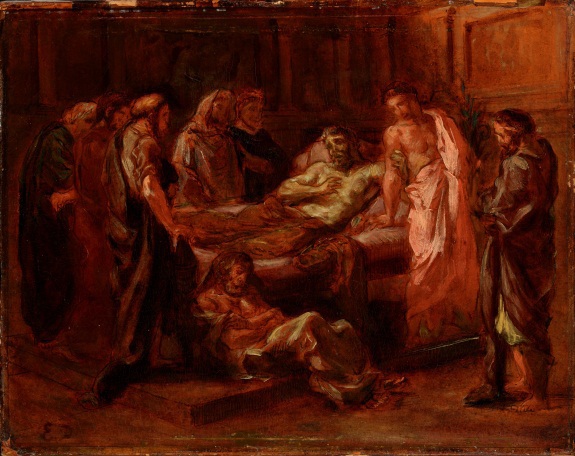
Eugène Delacroix
French, 1798-1863
The Last Words of Marcus Aurelius, sketch, 1843
Oil on canvas
10 1/4 x 13"
Musée des Beaux-Arts, Lyon
inv. B 1041
COMMENTS
Louis de Planet collaborated extensively in the preparation of this canvas. He reports in his Souvenirs, "‘In 1843, I painted the 'Marcus Aurelius' as far as I could after which Mr. Delacroix took over.”
It was not till 7 June that Delacroix gave de Planet the oil sketch, together with two drawings and detailed instructions for transferring his design to the large canvas, saying that he would return in two or three days. Presumably, de Planet left Paris for the summer at the end of June, as planned, having worked on the final canvas until his departure. Delacroix took over and had considerably advanced the work by 18 January 1844. … By February it was almost finished, but the finishing touches were apparently not applied until much later in the year, for “L’Artiste” reports at the end of October, "Mr. Eugène Delacroix finishes a painting of a great man, 'The Death of Marcus Aurelius.' ”
From the moment it was submitted to the Salon jury of 1845, the picture seems to have been the subject of controversy, and there are, indeed, reasons to believe that Delacroix himself was not entirely satisfied with it. It was accepted for the Salon on 3 March, by eleven votes to seven. The very fact that the votes were recorded in the proceedings of the jury, for this painting alone among the five Delacroix submitted, suggests that its acceptance was not easily won.
Though the State decided to acquire the picture by a decree of 24 June 1845, Delacroix requested that the “Sultan of Morocco and his Entourage” be taken in its place. … That Delacroix agreed, indeed sought, to have the much larger and clearly superior “Sultan of Morocco” substituted for the “Marcus Aurelius” strongly suggests that he had serious misgivings about the quality of the latter. These may have arisen from the degree of de Planet’s collaboration, which could account for a certain rigidity in some of the figures and a lack of vigor in several of the heads, which cannot be explained simply in terms of Stoic resignation, vestiges perhaps of the “lack of feelings” Delacroix noted when he took over from de Planet.
The subject, in any event, was close to Delacroix’s heart, being a theme that illustrated one of his abiding preoccupations, the fragility of civilization: the ideal of the philosopher king, of which the emperor Marcus Aurelius was perhaps the most perfect embodiment, is about to be desecrated by his profligate son and heir. … Delacroix first considered the subject for one of the paintings in the Palais Bourbon, but his interest in Marcus Aurelius dated from his student days, when he wrote a composition on him and did oral translations from his writings in Greek at the Collège de France.
- Lee Johnson, The Paintings of Eugène Delacroix, A Critical Catalog, v. III, Oxford, Clarendon Press, 1986, pp. 106-8
SBMA CURATORIAL LABELS
In 1845, Delacroix was 50 years old and at the height of his artistic powers. At the Salon that year, he chose to exhibit multiple canvases inspired by a variety of sources: Mary Magdalene in the Wilderness from the New Testament, The Cumean Sibyl, inspired by a story from the Iliad, and the visionary Sultan of Morocco, purportedly a portrait based on an event the artist witnessed during his voyage to North Africa in the company of the French Ambassador, the Count de Mornay in 1832 (presented here in facsimile to convey a sense of its actual scale). He also chose to exhibit the equally monumental Last Words of Marcus Aurelius (also presented here in facsimile and to scale), a subject from Roman history, whose precise origins we have identified in the 1800 French translation of the life of the stoic Emperor, that accompanied his famed Meditations and that Delacroix must have known.
This is the first exhibition to reunite some of the extant works produced by Delacroix in connection with the canvas now preserved in Lyon, several exhibited for the first time. In the artist‘s own words, he sought to represent the following: "The perverse inclinations of his son, Commodus, having already been manifested, in a dying voice, the emperor pleads the case for the youthfulness of his son to some of his friends, who were Stoic philosophers like himself. But their mournful attitude clearly shows that these urgings are in vain and anticipates the dark future of the Roman Empire." As predicted, Commodus turns out to be every bit as dissolute as Marcus Aurelius was virtuous, undoing his father‘s advancement of political consensus as the necessary foundation for imperial Roman rule.
- Delacroix and the Matter of Finish, 2013
